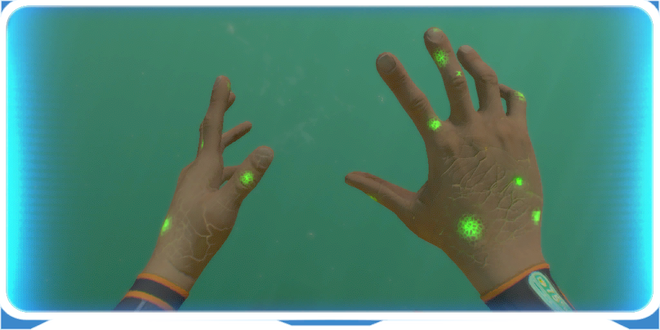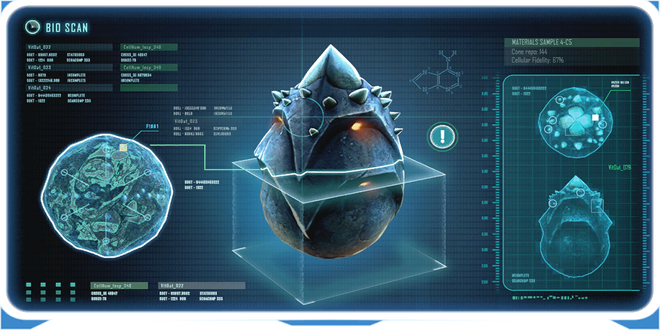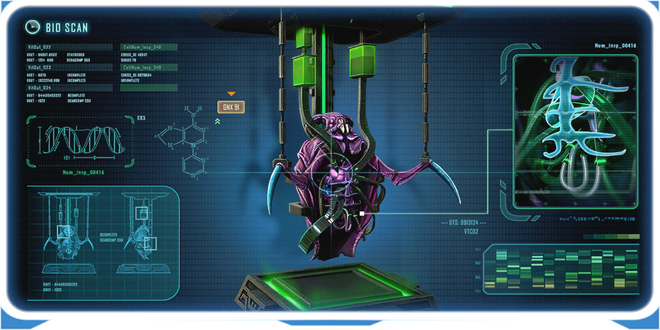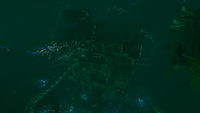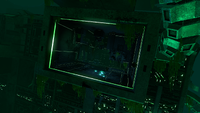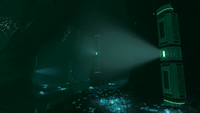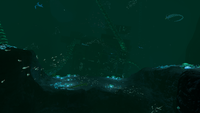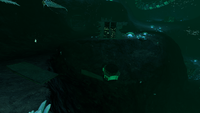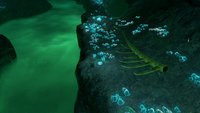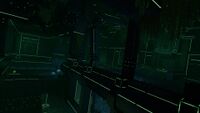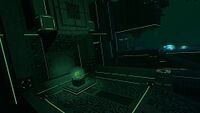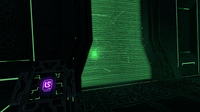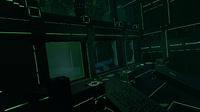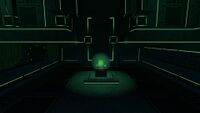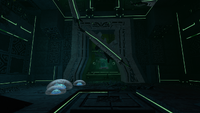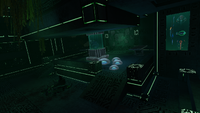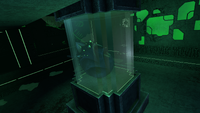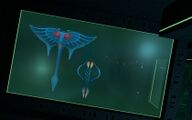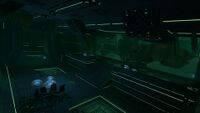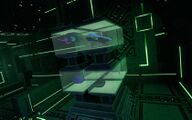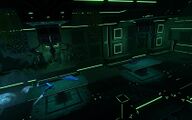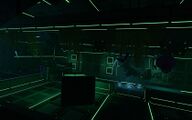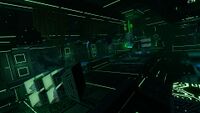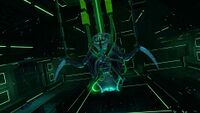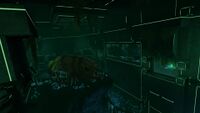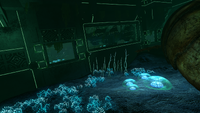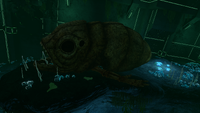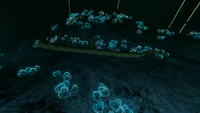Disease Research Facility

|
Read at own risk This article contains unmarked spoilers. Players new to the game would want to avoid or be cautious toward this article. |
<infobox layout="stacked">
<title source="title1"> <default>Disease Research Facility</default> </title> <image source="image1">
</image> <label>Tab</label> <label>Type</label> <label>Biome</label> <label>Cavern</label> <label>Depth Range</label> <label>Biome ID</label> <label>goto ID</label> <label>Coordinates</label> <label>Base ID</label> <label>Music</label> <group> <header>Map</header> <image source="image"> </image> <label>Adjacent Biomes</label> <label>Point of Interest</label> </group> </infobox>
Detecting an alien broadcast. Linguistic analysis reads: 'Caution: hazardous materials and lifeforms contained within. File:DRFMessage.ogg
― PDA, Dialogue
The Disease Research Facility is a destroyed Alien Base located in a cave that can be accessed from the Lost River Junction and the Mountains connection. Built around one thousand years ago, sometime before the imprisonment of the Sea Emperor Leviathan, the main purpose of this Disease Research Facility was to infect creatures with the Kharaa Bacterium to study their reaction to the disease. The sole specimen that survived the Kharaa Bacterium was sent to the Primary Containment Facility for further testing in order to synthesize a cure for the bacterium.
The Disease Research Facility is heavily damaged, and unlike the other bases, is completely filled with water. It lies partially suspended by several loose-hanging cables, with several sections of destroyed cables found scattered around the perimeter of the Disease Research Facility. The base was attacked and destroyed by a Sea Dragon Leviathan (which is found dead via its skeletal remains outside the base) in an attempt to retrieve its stolen egg - an event that also unleashed the Kharaa bacterium into the native ecosystem and prompted the Precursor Race to initiate their planetary quarantine by activating the Quarantine Enforcement Platform.
It is possible the Disease Research Facility was set up partially to study the skeleton in the Bones Field - the remains of a three-million-year-old super-predator. This is evidenced by the fact that the Precursors had taken samples from the aforementioned creature's ribcage.
Interior
The interior of the Disease Research Facility is accessible via an entrance on its northeast face near the top of the structure. It is mainly a straight path from the entrance to the Warper room, with some deviation. Starting at the entrance, the right-hand wall contains an Ion Cube and a force field room that can be unlocked with a Purple Tablet; this room contains a Data Download entitled "Alien Research Data". Continuing along the path, which turns left and downwards, there is another Ion Cube and a small tank on the left. The main path turns right into a room containing the Sea Dragon's egg and various fauna. The path turns right again, with a large aquarium on the left, accessible via a broken window, housing Skeletal Remains. At the end of the path is a room with various Warper parts, including a torso that can be scanned. A data terminal in this room, when interacted with, triggers the PDA to prompt the Player to perform a self-scan, which reveals the Kharaa Bacterium has spread to the skin on the player's hands.
Data Bank Entries
Kharaa Contagion Profile=
|
This terminal contains extensive data regarding the bacterial contagion identified as 'Kharaa'. Discovery: First encountered during routine network expansion on outer worlds. Pandemic Development: Network error resulted in routine quarantine procedure failure. Contagion was uploaded to, and spread quickly through, the core worlds. Confirmed deaths: 143 billion individuals. Bacterial Mechanisms: Attaches to healthy living cells and mutates the basic genetic structure. Symptoms: Stage 1: Gradual immune system failure. Stage 2: Green skin lesions and flu-like symptoms. Stage 3: Unpredictable alterations to biological structure. Stage 4: Complete shutdown of executive function. Emergency Steps Taken: Core worlds quarantined. Bacterial samples distributed to isolated disease research facilities for vaccine development. Treatment procedure: Unknown. |
|-| Bacterial Infection Report=
|
You have been infected with a previously unknown, waterborne bacterium. It is currently multiplying in your bloodstream. Estimated incubation time: 2 weeks. Your immune system is currently combating the infection at low efficiency. You may already be experiencing flu-like symptoms and skin irritation. These will likely be exacerbated as the bacterium takes hold. Your immediate priority should be abatement and eradication of the infection. Recommended steps: |
|-| Damaged Anchor Cable=
|
These thick cables were designed to anchor the nearby facility to the surrounding cave walls. Damage to some of the cabling has resulted in the facility collapsing to the floor. Calculations suggest such damage would require an external percussive force in excess of 300 tons. |
|-| Damage Report=
|
Leviathan detected at facility perimeter, closing at high speed. WARNING: Infected individuals may not leave the planet. |
|-| Remains of Research Specimen=
|
The skeletal remains of a vast predator, housed within an artificial habitat. 1. Habitat: 2. Evolution: |
|-| Specimen Research Data=
|
A catalog of information on the organisms previously contained within the alien facility. A number of entries have been translated. Small Herbivore Gamma: Leviathan Embryos: Large Carnivore Theta: Unidentified Leviathan: Assessment: While it is unlikely that the emperor specimen is still contained within the facility described, it may be possible to acquire further data there on the aliens' attempts to develop a vaccine. |
|-| Sea Dragon Egg=
|
This large egg is held in a hermetically sealed environment, and has been chemically sterilized. Without the means at the facility to house a fully grown sea dragon specimen, it is possible the aliens sought to study instead the egg-laying and incubation process. To what end is unclear. |
|-| Ray Species on 4546B=
|
Different species of ray indigenous to 4546B, each adapted to different environments. The specimens are 99.99% genetically identical to those encountered on the planet today, suggesting that rays in particular have undergone little evolutionary mutation in the past millennium. Ghostrays, jellyrays, crimson rays and rabbit rays likely all share a common evolutionary ancestor. The 'alpha ray' would have evolved deep in the ocean trenches, quickly growing in line with available food supplies. It would have most resembled the ghostray in size and appearance, with translucent skin for camouflage and forward-mounted eyes for hunting. A fast and fearsome stalker of small creatures in the dark. While some rays have stayed within the limits of the cave systems where they first evolved, others are relatively more recent adaptations to new environments, likely the results of overpopulation. All of the rays on 4546B have given up predation in favor of herbivorous scavenging, and use poisonous flesh to protect themselves. |
|-| Rib Cage Samples=
|
A display case containing an array of rib cages harvested from the indigenous lifeforms. There is a particular focus in this instance on vertebrate skeletal structures. While some of these skeletons match organisms encountered on the planet so far, most cannot be matched with confidence, suggesting either that there are species out there not yet accounted for, or that they have become extinct since these samples were collected. |
|-| Self-Warping Quarantine Enforcer Unit=
|
This lifeform shows signs of heavy genetic modification, and extensive mechanical grafting. Its digestive and pulmonary systems have been replaced by an onboard battery receiving energy directly from this facility and distributing it around the body. Miniaturized phase technology has been implanted beneath the skin and is triggered by the central nervous system, allowing the construct to teleport at will. The brain and central nervous system have been digitally augmented with advanced processing power and remote communications. Assessment: Programmable Hunter/Killer - Avoid |
|-| Warper Parts=
|
The organic parts on display contain DNA from dozens of different organisms, largely originating offworld. They are in varying states of augmentation with advanced technologies. This production line setup suggests these self-warping constructs were built, maintained and deployed by the aliens that designed this facility. |
|-| Production Line=
|
A production line of warper parts. |
Gallery
<tabber> Screenshots= <tabber> Exterior=
|-| Interior=
A tank with a Ghostray, Rabbit Ray and a Crimson Ray inside
Another tank with a Spadefish, a Hoopfish, and a Lava Larva inside
</tabber> |-| Concept Art=
Disease Research Facility Concept art by Pat Presley
</tabber>
Trivia
- The former name for the Disease Research Facility was the Secondary Bio-Research Facility.
Lua error in package.lua at line 80: module 'Dev:Navbox' not found.

